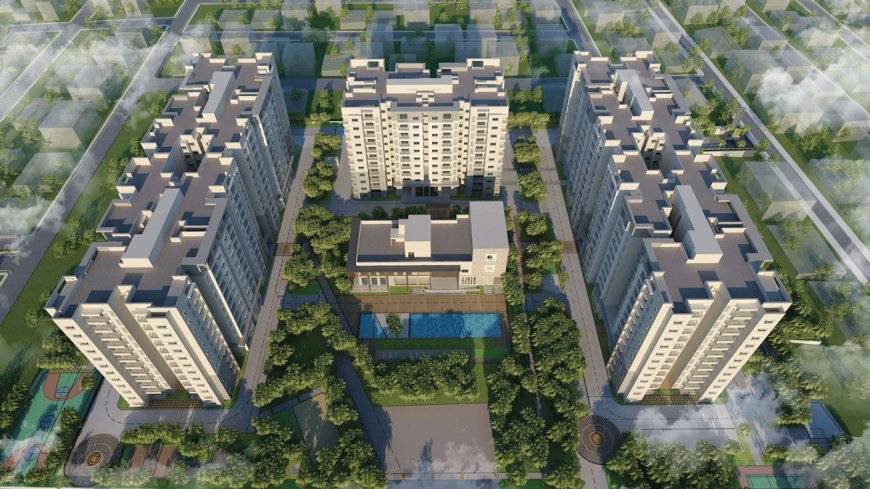On a strong growth path
The northern real estate market is on a transformative growth with more focused developments in the tier-2 cities as well as in the NCR. Construction Times presents the evolving market trends.

The northern real estate market is on a transformative growth with more focused developments in the tier-2 cities as well as in the NCR. Construction Times presents the evolving market trends.
India’s real estate market has seen tremendous growth in 2024-25 with increasing lease and sales trends. Equity investments in residential and commercial segments have witnessed some positive movements in the real estate market. The Northern India market is continuing its growth momentum in this year also with a number of new projects coming up in residential segment. The luxury and ultra-luxury markets have seen considerable growth last year.
Growing market
Real estate market in the north has seen considerable growth in the recent past. Residential real estate market in the region has grown in property rates and sales in the last two years due to demand surge. The year 2024 marked a particularly significant milestone with record-high new supply levels.
The commercial real estate market in the northern region has also flourished in the past year with a slew of premium commercial spaces coming up especially in the Delhi-NCR region. According to the recent CBRE report on office spaces, Delhi-NCR are likely to dominate new completions. Developers are exhibiting a growing emphasis on building state-of-the-art facilities with amenities catering to the evolving requirements of modern businesses. The trend is likely to continue this year as well.
 Highlighting the trend in the residential segment, Santhosh Kumar, Vice Chairman, ANAROCK Group, says, “Approximately 211,700 new residential units were launched between 2019 and Q1 2025 in NCR. Housing demand has outpaced supply with the absorption of 313,900 units, leaving only 84,500 units available for sale by the end of Q1 2025.” According to him, the average property prices across the NCR have appreciated by 82% between 2019 and Q1 2025, with the current (Q1 2025) average property price of NCR standing at Rs 8,330/sf. Among all the zones of NCR, Greater Noida, Noida and Gurugram witnessed the highest price appreciation of 98%, 92% and 84%, respectively. Gurugram dominates the NCR market with 143,500 units absorbed between 2019 and Q1 2025, representing 46% of the region's total absorption.
Highlighting the trend in the residential segment, Santhosh Kumar, Vice Chairman, ANAROCK Group, says, “Approximately 211,700 new residential units were launched between 2019 and Q1 2025 in NCR. Housing demand has outpaced supply with the absorption of 313,900 units, leaving only 84,500 units available for sale by the end of Q1 2025.” According to him, the average property prices across the NCR have appreciated by 82% between 2019 and Q1 2025, with the current (Q1 2025) average property price of NCR standing at Rs 8,330/sf. Among all the zones of NCR, Greater Noida, Noida and Gurugram witnessed the highest price appreciation of 98%, 92% and 84%, respectively. Gurugram dominates the NCR market with 143,500 units absorbed between 2019 and Q1 2025, representing 46% of the region's total absorption.
The commercial office market has shown resilience and growth in the past year. According to Santhosh Kumar, the net office absorption in NCR reached 9.5 mn sf in 2024, surpassing the pre-pandemic level of 8.6 mn sf in 2019. Flexible workspaces/Co-working providers have emerged as a dominant force in the Grade-A office leasing market, capturing a 34% share in 2024, reflecting the evolving workplace preferences in the post-pandemic era.

While Delhi NCR continues to be the anchor of real estate growth in the north market, the uptick is no longer limited to the capital region alone. Supriya Chatterjee, Managing Director - North, Cushman & Wakefield, elaborates, “Tier-II cities like Lucknow and Jaipur are increasingly making their presence felt - particularly in land transactions, with developers announcing plans to build new retail and hospitality projects in these emerging cities. Lucknow, in particular is a key beneficiary of the return to office mandate, supported by the combination of state government’s policy push and companies’ strategy to go, where they can find employable talent pool.”
Challenges
The real estate market in the region is facing a slew of challenges on various fronts. Rising construction costs, regulatory complexities and approval delays, environmental concerns, and global economic uncertainties are some of the challenges faced by the market. Bringing in more sustainable practices into real estate development and construction continues to be challenging in the upcoming market scenario. According to Chatterjee, there remains significant potential for broader integration of green practices across the industry- something that can further enhance buyer confidence and meet the evolving expectations of corporate occupiers. “The way forward lies in streamlining regulations and simplifying compliance to reduce the burden on developers. A holistic region-wide infrastructure development can bring synergy and address last-mile connectivity concerns. Strengthening government schemes like Pradhan Mantri Awas Yojana (PMAY) and encouraging developers to pursue a balanced mix of product offerings can help address the issue of high property prices. Lastly, promoting green building practices and ensuring environmental sustainability can make the region more attractive to buyers concerned about long-term environmental impact,” she adds.

Evolving market dynamics
The real estate market in North India is on a strong growth path, fuelled by large-scale infrastructure projects and rising investor confidence. According to Ashish Bhutani, CEO, Bhutani Infra, one of the most transformative developments in the region is the upcoming Noida International Airport, which is creating ripple effects across sectors, especially real estate. “We see this as a moment of opportunity and are actively expanding our portfolio to align with the region’s evolving dynamics,” he adds.

Pradeep Aggarwal, Founder & Chairman, Signature Global (India) Ltd, highlights more on the growth facilitators, “Significant investments have been made in enhancing connectivity through growth corridors like the Dwarka Expressway, Southern Peripheral Road, Sohna, and New Gurugram. These are further supported by government-led initiatives. Additionally, the development of high-quality social infrastructure—such as schools, healthcare facilities, and retail spaces—has further fuelled demand for residential properties. This development has contributed to a notable rise in property prices.”
On a positive outlook
According to Santhosh Kumar, the outlook for NCR's real estate market remains optimistic with sustained growth expected in the medium to long term. “The residential segment is likely to maintain its momentum, with luxury and ultra-luxury segments gaining traction as wealth creation continues among high-net-worth individuals,” he adds. Chatterjee also remains positive on the market outlook as she projects, “The office sector is expected to witness ~20 msf of new supply between 2025 and 2027, while the retail sector is set for a significant boost with the opening of several large, institutionally owned malls during the same period. There is also an increased interest from reputed pan-India developers, many of whom are exploring opportunities to expand into North India, particularly in the high growth Delhi NCR region.”
The region is expected to attract sustained investment and development activity across the real estate segments in the coming years as well.







